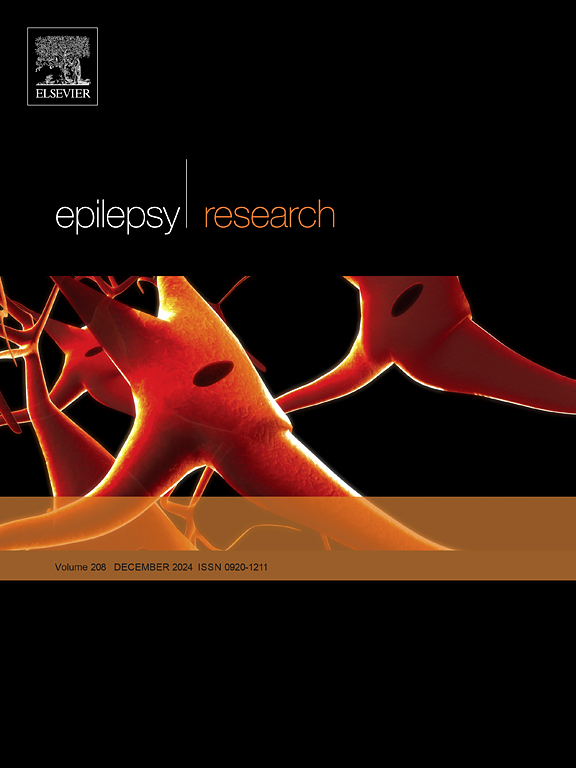Deep brain stimulation for epilepsy: A systematic review and meta-analysis of randomized and non-randomized studies of thalamic targeting
IF 2
4区 医学
Q3 CLINICAL NEUROLOGY
引用次数: 0
Abstract
Introduction
Deep Brain Stimulation (DBS) of the thalamus for drug-resistant epilepsy (DRE) is an emerging treatment modality. This systematic review and meta-analysis sought to evaluate the efficacy of stimulating different targets within the thalamus.
Methods
A systematic search of four databases was conducted. Rates for overall seizure reduction (SR), responder rate (RR ≥50 % SR), and seizure freedom (SF) were evaluated at a minimum time point of 12 months post-stimulation commencement in the anterior (ANT) and centro-median (CMN) thalamic nuclei. Subgroup analyses for a minimum 24 months follow up, sensitivity analyses, and funnel plots to assess for publication bias were also performed. Risk of bias was assessed using the ROBINS-I tool.
Results
Fourty-nine articles met the inclusion criteria. The mean seizure reduction (SR) across 21 studies was 62.31 % (95 % CI: 55.99–68.62, p < 0.01). Specifically, SR was 64.28 % for ANT (95 % CI: 57.55–71.01, p < 0.01) and 69.11 % for CMN (95 % CI: 58.14–80.09, p < 0.01). Meta-analyses of 41 ANT studies and 12 CMN studies reported a response rate (RR) of 61.51 % (95 % CI: 54.11–68.9, p < 0.01) and 69.09 % (95 % CI: 54.01–84.16, p < 0.01), respectively. Overall seizure freedom (SF) was 3.57 % % for ANT (95 % CI: 1.86–5.28, p = 0.45) and 1.32 % for CMN(95 % CI: 0–4.45, p = 0.81). For ANT, RR was 67.63 % (95 % CI: 61.04–74.23) for follow-up periods longer than 24 months, and 44.05 % (95 % CI: 26.73–61.38) for periods shorter than 24 months. The SF rate for ANT was 3 % (95 % CI: 1–4 %) for follow-up under 12 months. For CMN, RR was 70 % (95 % CI: 53–87 %) for periods over 24 months, and 68 % (95 % CI: 31–100 %) for periods under 24 months. The SF rate for CMN was 1 % (95 % CI: 0–4 %) for periods under 12 months. There was no strong evidence of publication bias based on funnel plot analysis, and results were consistent across sensitivity analyses. Insufficient data precluded meta-analysis for other nuclei.
Conclusion
These findings demonstrate efficacy of ANT and CMN DBS for patients with DRE, defined by responder rate and seizure reduction. Further research is required to optimize patient selection, predict individual response, and assess non-seizure related outcomes.
深部脑刺激治疗癫痫:随机和非随机丘脑靶向研究的系统回顾和荟萃分析
丘脑深部脑刺激(DBS)治疗耐药性癫痫(DRE)是一种新兴的治疗方式。本系统综述和荟萃分析旨在评估刺激丘脑内不同靶点的效果。方法系统检索4个数据库。在刺激开始后12个月的最小时间点评估丘脑前核(ANT)和中-中核(CMN)的总体癫痫发作减少率(SR)、反应率(RR≥50 % SR)和癫痫发作自由率(SF)。还进行了至少24个月随访的亚组分析、敏感性分析和漏斗图评估发表偏倚。使用ROBINS-I工具评估偏倚风险。结果49篇文章符合纳入标准。21项研究的平均癫痫发作减少率(SR)为62.31 %(95 % CI: 55.99-68.62, p <; 0.01)。具体来说,ANT的SR为64.28 %(95 % CI: 57.55-71.01, p <; 0.01),CMN的SR为69.11 %(95 % CI: 58.14-80.09, p <; 0.01)。41项ANT研究和12项CMN研究的荟萃分析显示,缓解率(RR)分别为61.51 %(95 % CI: 54.11-68.9, p <; 0.01)和69.09 %(95 % CI: 54.01-84.16, p <; 0.01)。ANT组的总癫痫发作自由度(SF)为3.57 % %(95 % CI: 1.86-5.28, p = 0.45),CMN组为1.32 %(95 % CI: 0-4.45, p = 0.81)。对于ANT,随访时间超过24个月的RR为67.63 %(95 % CI: 61.04-74.23),随访时间短于24个月的RR为44.05 %(95 % CI: 26.73-61.38)。随访不到12个月,ANT的SF率为3 %(95 % CI: 1-4 %)。对于CMN, 24个月以上的RR为70 %(95 % CI: 53-87 %),24个月以下的RR为68 %(95 % CI: 31-100 %)。CMN的SF率在12个月以下为1 %(95 % CI: 0-4 %)。没有强有力的证据表明漏斗图分析存在发表偏倚,敏感性分析的结果是一致的。由于资料不足,无法对其他核进行meta分析。结论这些发现证实了ANT和CMN DBS对DRE患者的疗效,通过反应率和癫痫发作减少来定义。需要进一步的研究来优化患者选择,预测个体反应,并评估非癫痫相关的结果。
本文章由计算机程序翻译,如有差异,请以英文原文为准。
求助全文
约1分钟内获得全文
求助全文
来源期刊

Epilepsy Research
医学-临床神经学
CiteScore
0.10
自引率
4.50%
发文量
143
审稿时长
62 days
期刊介绍:
Epilepsy Research provides for publication of high quality articles in both basic and clinical epilepsy research, with a special emphasis on translational research that ultimately relates to epilepsy as a human condition. The journal is intended to provide a forum for reporting the best and most rigorous epilepsy research from all disciplines ranging from biophysics and molecular biology to epidemiological and psychosocial research. As such the journal will publish original papers relevant to epilepsy from any scientific discipline and also studies of a multidisciplinary nature. Clinical and experimental research papers adopting fresh conceptual approaches to the study of epilepsy and its treatment are encouraged. The overriding criteria for publication are novelty, significant clinical or experimental relevance, and interest to a multidisciplinary audience in the broad arena of epilepsy. Review articles focused on any topic of epilepsy research will also be considered, but only if they present an exceptionally clear synthesis of current knowledge and future directions of a research area, based on a critical assessment of the available data or on hypotheses that are likely to stimulate more critical thinking and further advances in an area of epilepsy research.
 求助内容:
求助内容: 应助结果提醒方式:
应助结果提醒方式:


